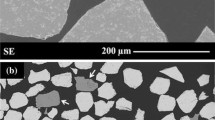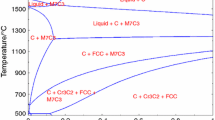Abstract
The behavior of a natural chromite from the Bushveld Complex, Transvaal, South Africa, during reduction at 1416 °C by graphite was studied by means of thermogravimetric analysis, X-ray diffraction (XRD) analysis, energy-dispersive X-ray analysis (EDAX), and metallographic analysis. Experimental runs were allowed to proceed up to 120 minutes, resulting in 99 pct reduction. The specific objective of this study was to delineate the reduction mechanism of chromite by graphite. Zoning was observed in partially reduced chromites with degrees of reduction of up to about 70 pct. The inner cores were rich in iron, while the outer cores were depleted of iron. Energy-dispersive X-ray analysis revealed that Fe2+ and Cr3+ ions had diffused outward, whereas Cr2+, Al3+, and Mg2+ ions had diffused inward. The following mechanism of reduction, which is based on the assumption that the composition of the spinel phase remains stoichiometric with increasing degree of reduction, is proposed, (a) Initially, Fe3+ and Fe2+ ions at the surface of the chromite particle are reduced to the metallic state. This is followed immediately by the reduction of Cr3+ ions to the divalent state, (b) Cr2+ ions diffusing toward the center of the particle reduce the Fe3+ ions in the spinel under the surface of the particle to Fe2+ at the interface between the inner and outer cores. Fe2+ ions diffuse toward the surface, where they are reduced to metallic iron, (c) After the iron has been completely reduced, Cr3+ and any Cr2+ that is present are reduced to the metallic state, leaving an iron- and chromium-free spinel, MgAl2O4.
Similar content being viewed by others
References
G.C. Ulmer and W.B. White:J. Am. Ceram. Soc., 1966, vol. 49(1), pp. 50–51.
R.W.G. Wyckoff:Crystal Structures, 2nd ed., Interscience Publishing Co., New York, NY, 1962, vol. 3, pp. 77–78.
K.P.D. Perry: Ph.D. Thesis, University of the Witwatersrand, Johannesburg, Republic of South Africa, 1986.
F.A. Kroger:The Chemistry of Imperfect Crystals, 2nd ed., North-Holland/American Elsevier, Amsterdam, The Netherlands, 1974, vol. 2, pp. 251–55.
J.E. Castle and P.L. Surman:J. Phys. Chem., 1967, vol. 71, pp. 4255–59.
W.D. Kingery, D.C. Hill, and R.P. Nelson:J. Am. Ceram. Soc., 1960, vol. 43 (9), pp. 473–76.
E.J.M. Verwey:Z. Kristallogr., 1935, vol. 91, pp. 65–69.
E. Kordes:Z. Kristallogr., 1935, vol. 91, pp. 193–228.
G. Kullerud, G. Donnay, and J.D.H. Donnay:1968 Year Book, Carnegie Institute, Washington, DC, vol. 66, pp. 497-98.
G. Kullerud, G. Donnay, and J.D.H. Donnay:Z. Kristallogr., 1969, vol. 128 (1–2), pp. 1–17.
R. Dieckmann and H. Schmalzried:Ber. Bunsen-Ges. Phys. Chem., 1977, vol. 81 (4), pp. 414–19.
W. Mueller and H. Schmalzried:Ber. Bunsen-Ges. Phys. Chem., 1964, vol. 68 (3), pp. 270–76.
T.O. Mason and H.K. Bowen:J. Am. Ceram. Soc., 1981, vol. 64 (2), pp. 86–90.
J.W. Halloran and H.K. Bowen:J. Am. Ceram. Soc., 1980, vol. 63 (1–2), pp. 58–65.
W.J. Rankin:Arch. Eisenhuettenwes., 1979, vol. 50 (9), pp. 373–78.
E.D. Kinloch: inICAM 81, Proc. 1st Int. Congress on Applied Mineralogy, J.P.R. de Villiers and P.A. Cawthorn, eds., The Geological Society of South Africa, Johannesburg, Republic of South Africa, 1983, pp. 337–49.
M.J. Searle and C.W.P. Finn: Report No. M96, Council for Mineral Technology, Randburg, Republic of South Africa, 1984.
T.R.C. Feraandes: inMINTEK 50, Proc. Int. Conf. on Mineral Science and Technology, L.F. Haughton, ed., Council for Mineral Technology, Randburg, Republic of South Africa, 1985, vol. 2, pp. 913-22.
N.L. Woollacott: Report No. 1950, National Institute for Metallurgy, Randburg, Republic of South Africa, 1978.
C.S. Kucukkaragoz, S.H. Algie, and C.W.P. Finn: MINTEK Report No. M154, Council for Mineral Technology, Randburg, Republic of South Africa, 1984.
C. Greskovich and V.S. Stubican:J. Phys. Chem. Solids, 1966, vol. 27, pp. 1379–84.
A. Novakova, C. Kleir, and J.S. Jiru: inReactivity of Solids, G.M. Schwab, ed., Elsevier, New York, NY, 1965, pp. 269–76.
O. Katsutoshi and S. Awazu:J. Phys. Chem. Solids, 1968, vol. 29, pp. 1269–73.
E.J.W. Verwey and E.L. Heilmann:J. Chem. Phys., 1947, vol. 15, pp. 174–80.
S.A. De Waal and S.A. Hiemstra: Report No. 1709, National Institute for Metallurgy, Randburg, Republic of South Africa, 1975.
F. Freund, H. Kathrein, H. Wengeler, R. Knobel, and H.J. Heinen:Geochim. Cosmochim. Acta, 1980, vol. 44, pp. 1319–33.
H. Wengeler: Ph.D. Thesis, University of Cologne, Cologne, Federal Republic of Germany, 1980.
A. Navrotsky and O.J. Kleppa:J. Inorg. Nucl. Chem., 1967, vol. 29, pp. 2701–14.
J.O. Edstrom:J. Iron Steel Inst., 1953, vol. 175, pp. 289–304.
J.O. Edstrom:Jernkontorets Ann. 141, 1957, vol. 12, pp. 809–31.
Author information
Authors and Affiliations
Additional information
Formerly Postgraduate Student, Department of Metallurgy and Materials Engineering, University of the Witwatersrand.
Formerly with the Department of Metallurgy and Materials Engineering, University of the Witwatersrand.
Rights and permissions
About this article
Cite this article
Soykan, O., Eric, R.H. & King, R.P. The reduction mechanism of a natural chromite at 1416 °C. Metall Trans B 22, 53–63 (1991). https://doi.org/10.1007/BF02672527
Received:
Issue Date:
DOI: https://doi.org/10.1007/BF02672527




